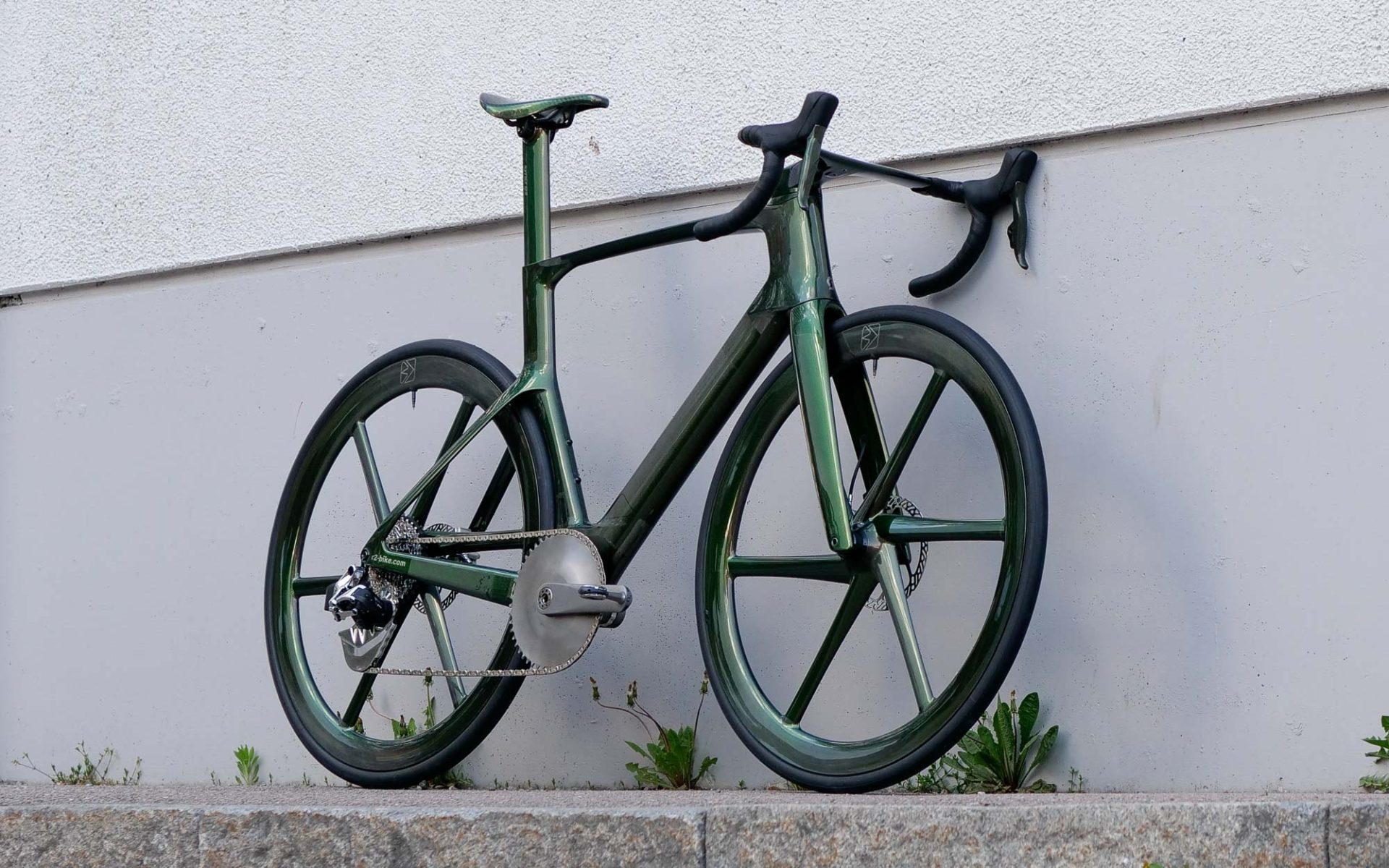If you’re a fan of weight-weenie mountain bikes, like watching Instagram reels of new carbon frames being scraped with a knife, or just into overly short jorts, then chances are you’ll need no introduction to Gustav Gullholm, aka, Dangerholm.
If you’re left wondering what the heck a Dangerholm is, this eccentric Norweigen-born Swede has built a reputation in the mountain bike world for doing some of the most innovative, prettiest, lightest, and/or bravest bike builds based around commonly available frames. Now, Gullholm has turned his attention to his first road bike – a Scott Foil.
Based around a production frameset and cockpit, this bike arguably features less in the way of truly out-of-the-box thinking compared to some of Dangerholm’s previous builds. Still, it’s pleasing to the eyes (at least for most) and offers a build list full of parts likely to be foreign to many. So with that, enjoy.
The Scott Foil Liquid
According to Gullholm, the goal was to build a bike that offers the aesthetics of being a complete package, rather than a collection of parts. “The goal was that it would in some ways resemble and bring the feeling of looking at a beautiful supercar,” Gullholm told Escape Collective. “When looking at a supercar, all the body panels are matching, the wheels are clean and so on. I’m not saying a cool bike with a bunch of cool parts and logos can’t look great, but the bike will visually appear in a very different tone if done more in the style shown here. To me, it will be easier on the eye, more beautiful, and a bit more timeless.”
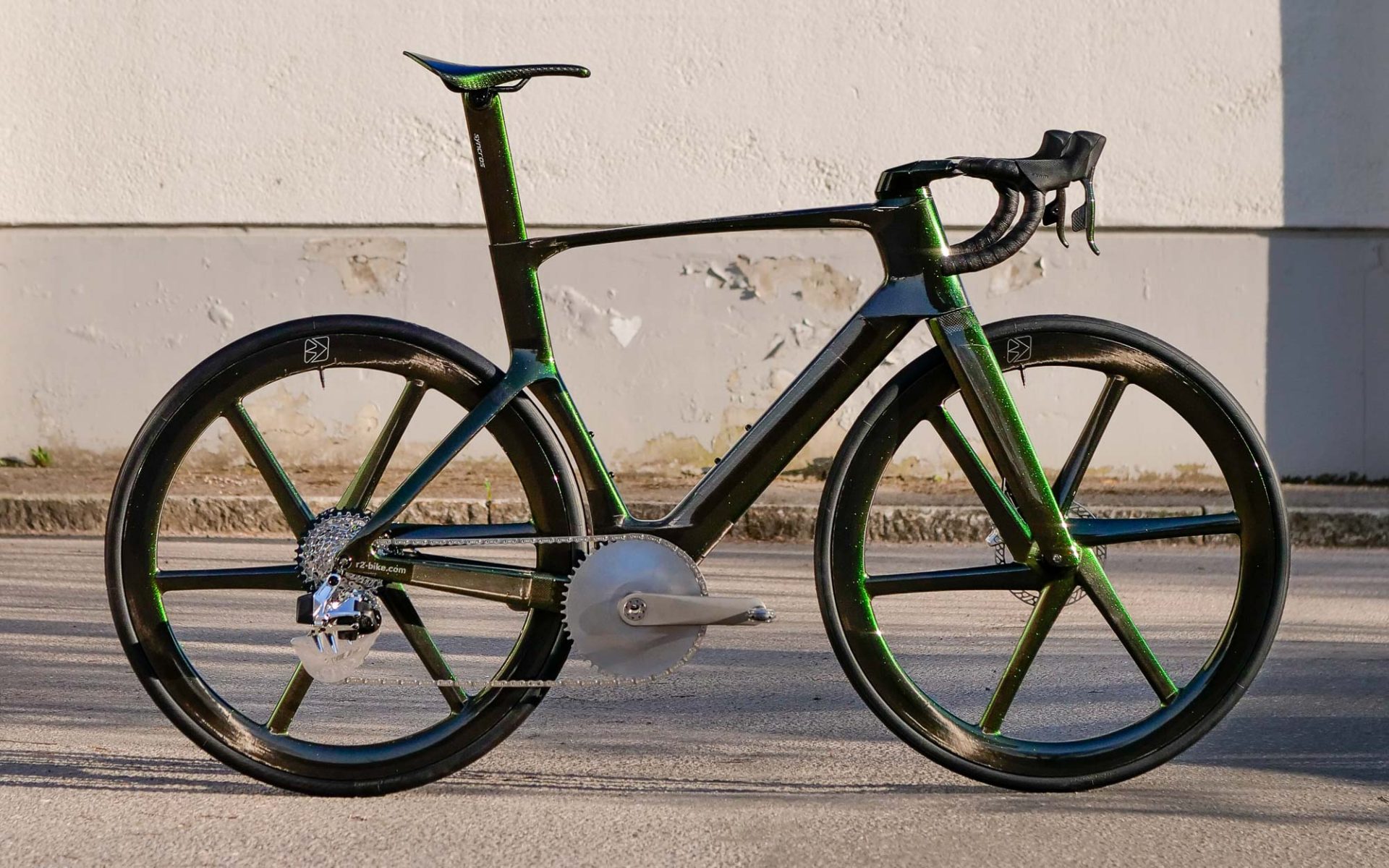
Where some of Gullholm’s previous bikes have gone after absolute lightness, many of his more recent builds have instead prioritised aesthetics and/or functionality while remaining weight competitive. At 7.11 kg (with pedals), this Scott Foil manages just that with a weight that defies some of the more aesthetic and function-based component choices.
Many of Gullholm’s part choices on this build should be enough proof that this was no weight-weenie build, but the most apparent sign is seen with the use of the RC-level frame, which uses Scott’s second-tier HMX carbon fibre lay-up. According to Gullholm, this was simply a matter of availability and wanting to build up a test bike sooner to spend time on it to get a feel for the build and required fit.
No doubt the hundreds of hours of work put into the paint is what ties the whole plan together, and here the original Scott Foil RC frame and many of the components were carefully stripped to bare carbon (including the use of a knife, no doubt), given a transparent primer, then coated in “Liquid Gold” paint, followed by a clear coat.
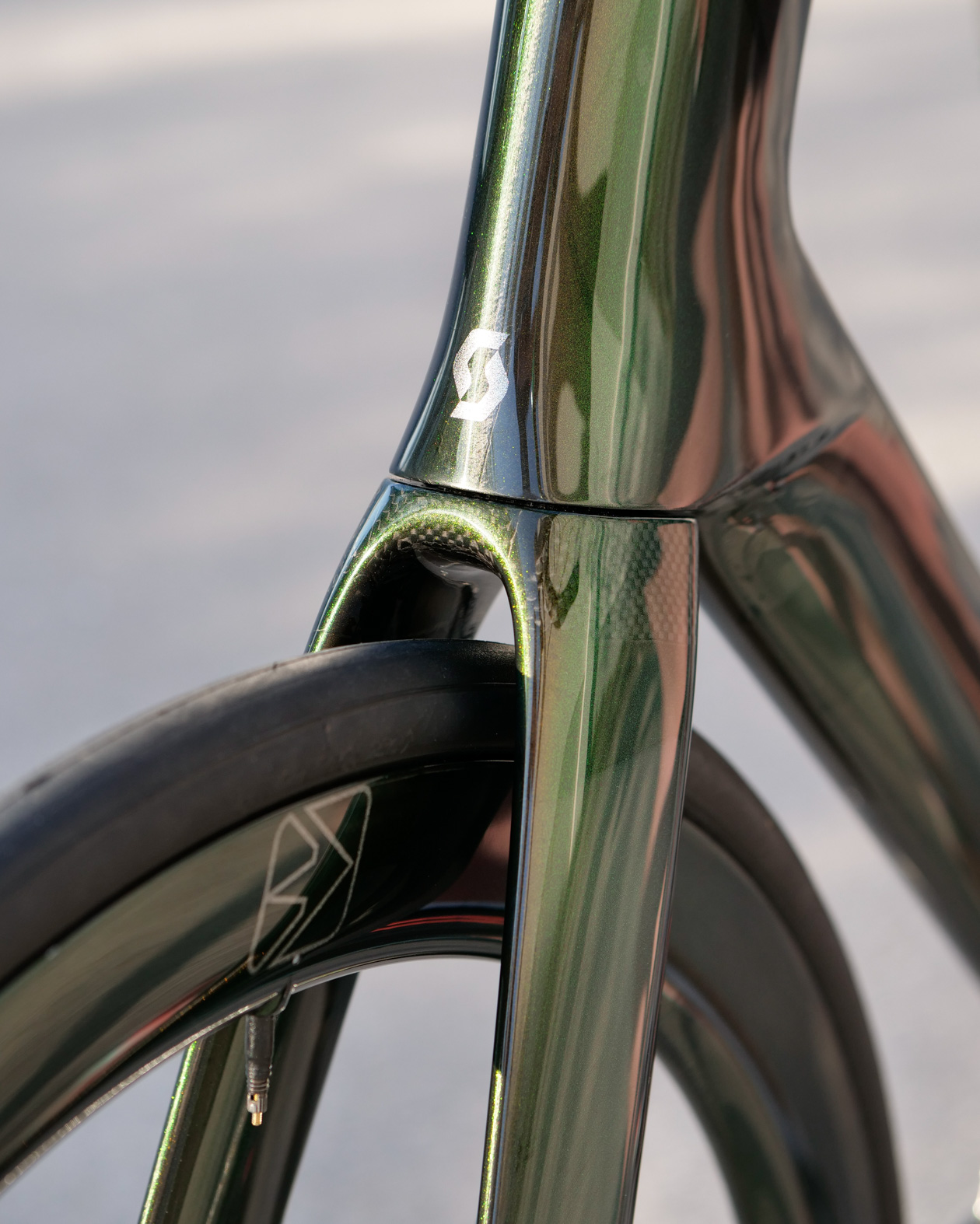
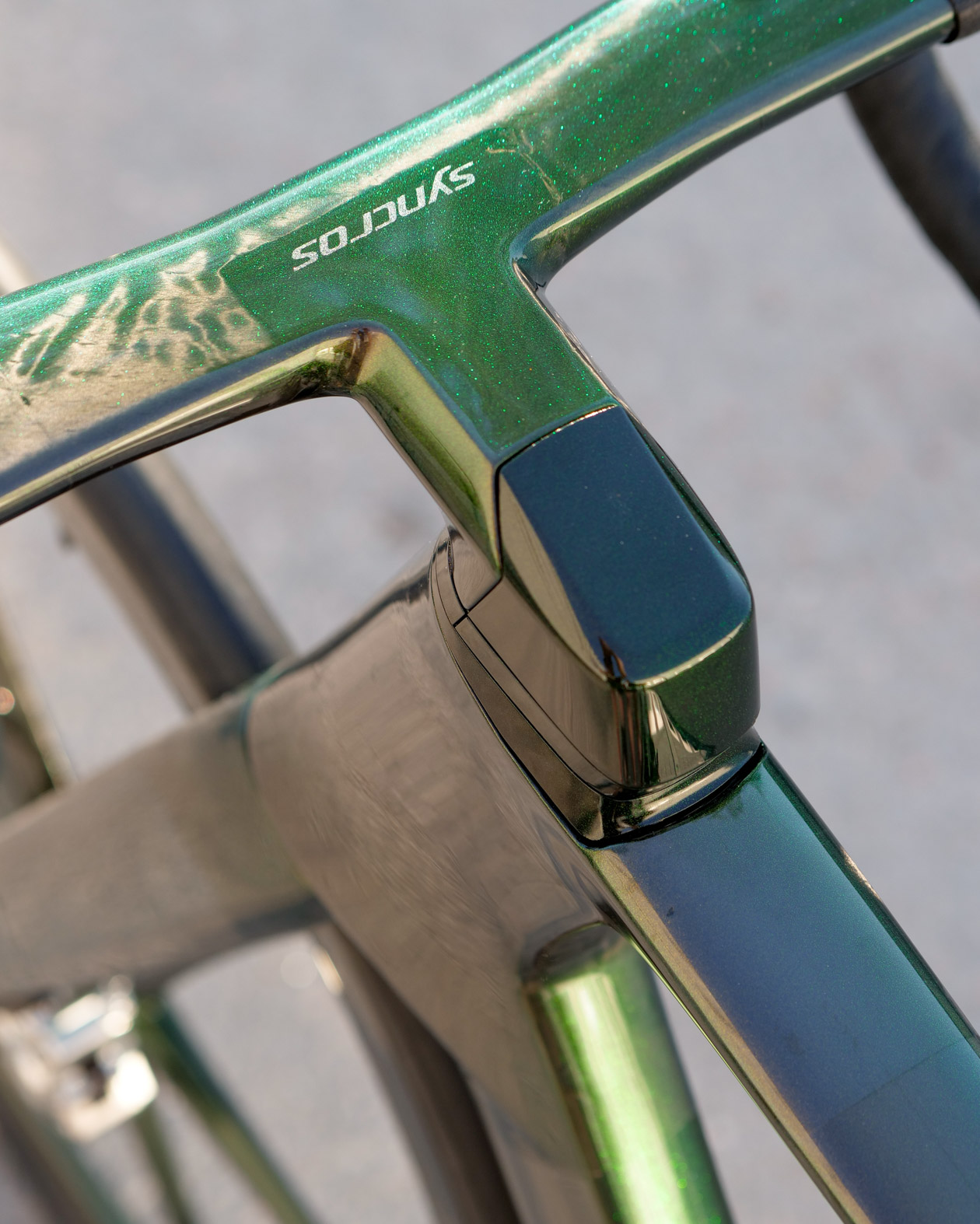
“It shifts dramatically from being completely transparent, allowing the black carbon fiber to be visible as if just clear coated, to flipping between green, gold and in some angles even blue tones,” said Gullholm of the impressive coating. “In low light, the bike becomes much more discreet with glossy olive tones.”
It’s a thin paint that is said to add only add 36 grams over the bare Foil RC frame (888 g, including hardware and seat clamp in a size L/56 cm).
Rolling stock
One of the more eye-catching elements of the bike are the six-spoke and one-piece Bike Ahead Composites Aero wheels. Not approved for use in UCI-sanctioned road events, these 1,450-gram German-made clincher wheels do assist with the supercar aesthetic. “The spokes completely disappear when you look at the wheels straight on, compared to most others where you can see the spokes flare out at the hub.”
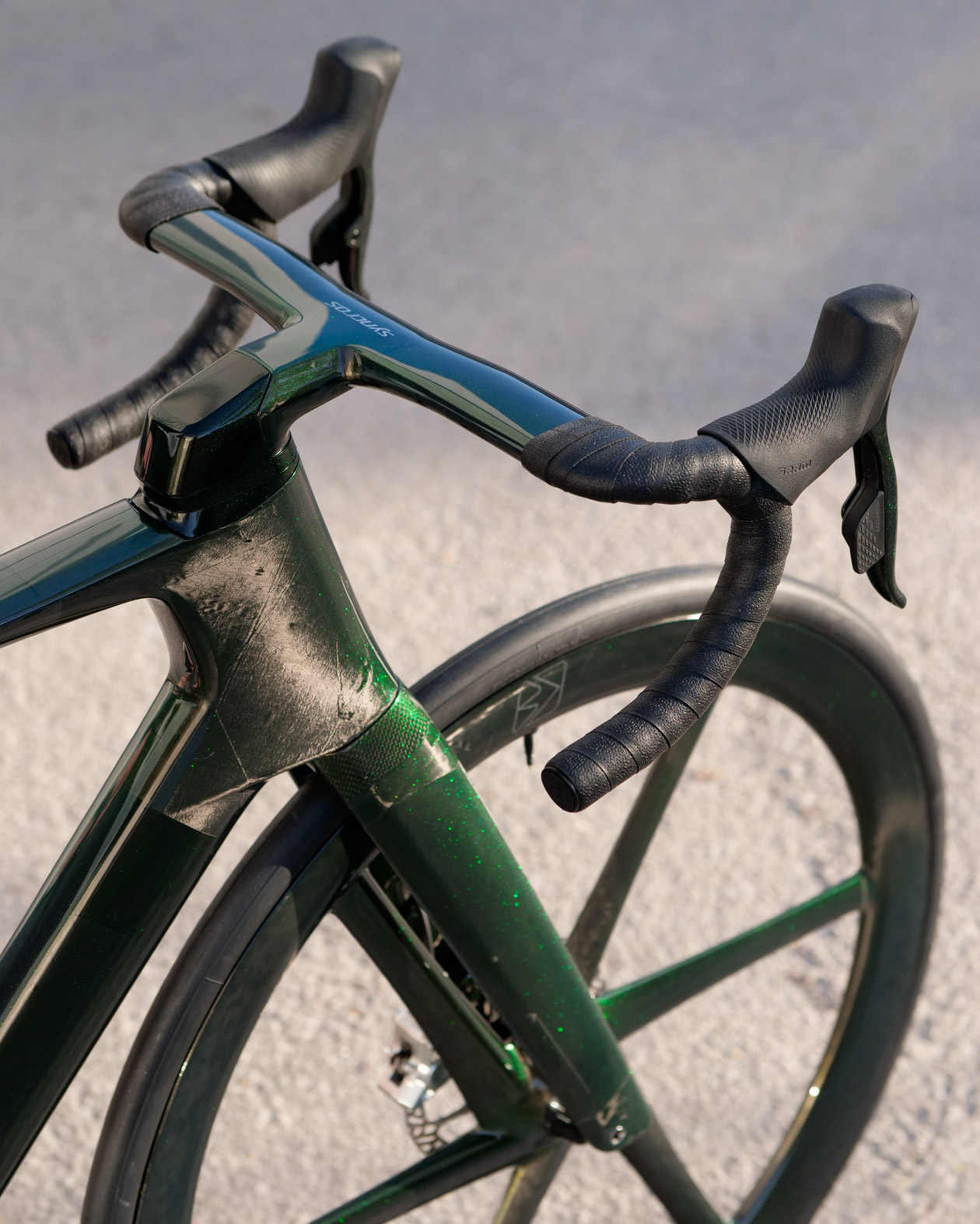
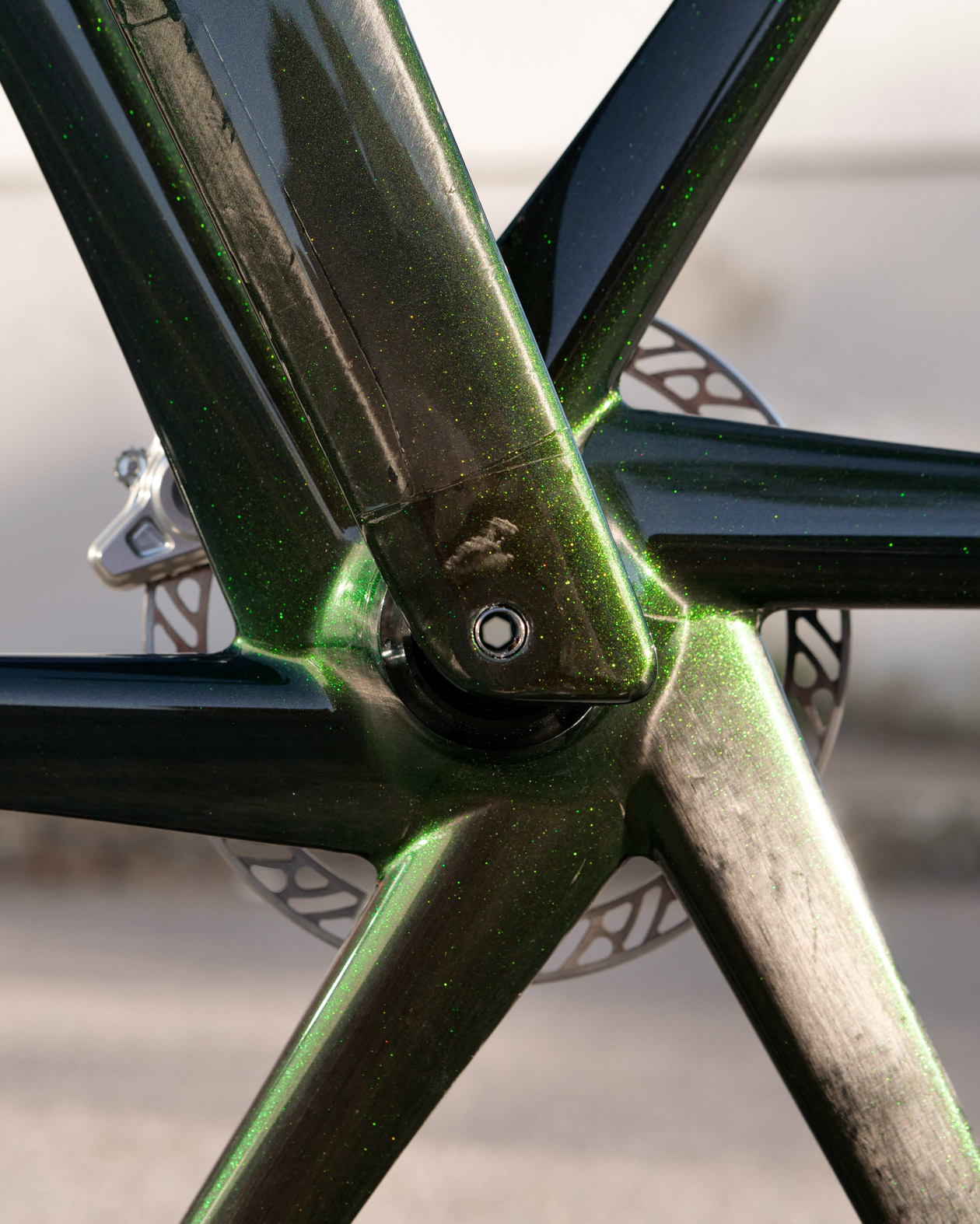
Those are wrapped with Michelin Power Cup Competition Line tyres, with an aero-inspired approach of a narrower 25 mm width up front, and a 28 mm tyre at the rear. Revoloop’s Ultra Race TPU tubes retain the air. Gullhom could have hidden the logos with a Sharpie pen, but instead chose to remove them permanently, “I managed to remove the logos by folding high-quality 400-grit sanding paper (Mirka) and using an edge of the paper to remove the logo. Problem is this method doesn’t always work, depending on the type of logo patch or if the rubber covering the [casing] weave is too thin and sensitive.”
The wheels are secured into the bike with titanium thru-axles from Italian manufacturer METI.
Drivetrain and brake choices
The drivetrain is one area where Gullholm’s bikes always offer a talking point, and this build – with its titanium 3D-printed cranks from Britain’s Sturdy Cycles and mirror-polished derailleur – is no different.
While those cranks are offered with 1x and 2x titanium chainring options, Gullholm elected to go with the aero 50T single-ring. That heavy, but more durable, titanium chainring is paired with all titanium hardware, the only exception being the aluminium bearing preload adjuster. Even the hidden axle is a machined titanium piece from METI.

“I decided on running a 1x drivetrain partially because of the aero benefits, but also coming from mountain biking I’m quite used to having slightly bigger gearing steps and don’t feel it’s very problematic. Depending on where I ride and how much climbing there is to do, I have two SRAM Force cassettes for the bike. One is a 10-36T for flatter rides and the other is a 10-44T to use when necessary.”
Those cassettes are paired with a SRAM RED AXS XPLR rear derailleur (from SRAM’s gravel range). This derailleur has certainly had its warranty voided many times over by being pulled to pieces, polished, and fitted with a Kogel Kolossos Aero derailleur cage.

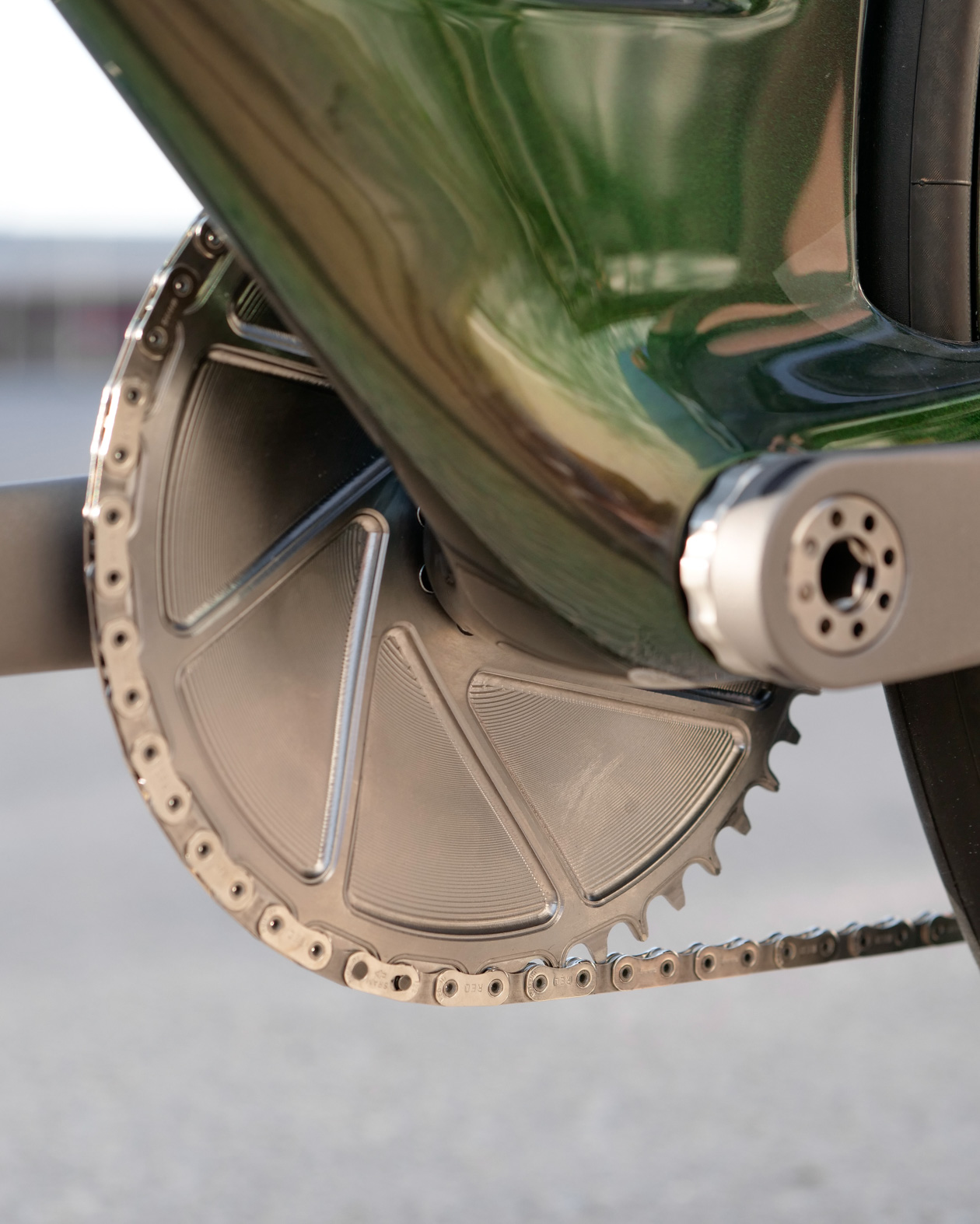
“This bike is the reason as to why this cage came to life. I had originally planned to run a regular Kolossos oversize derailleur cage system, but Kogel stepped it up and designed this Aero version to perfectly fit with the theme of the bike. Used on this bike is the first pre-production unit, which has been custom polished by me, and hopefully the production version will become available this summer.”
Gullholm told Escape that there were initially plans for further titanium within the drivetrain – including mods to the rear derailleur and a titanium cassette – but those didn’t come to fruition.
Shifting that rear derailleur is a pair of SRAM RED AXS levers that have had the brake levers painted to match the rest of the bike. Those shifters/levers are connected to the C22 flat mount brake calipers from German brake manufacturer Trickstuff.
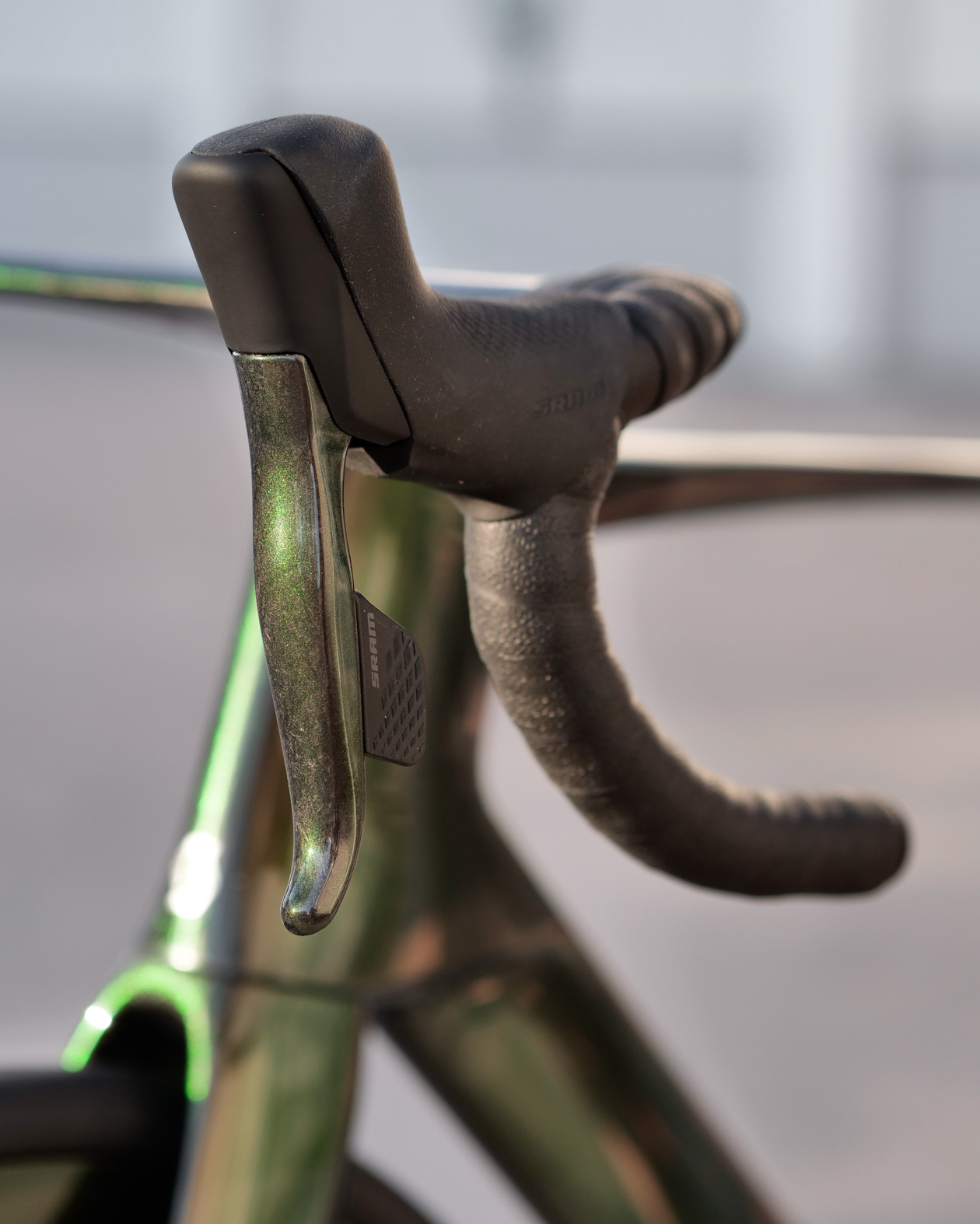
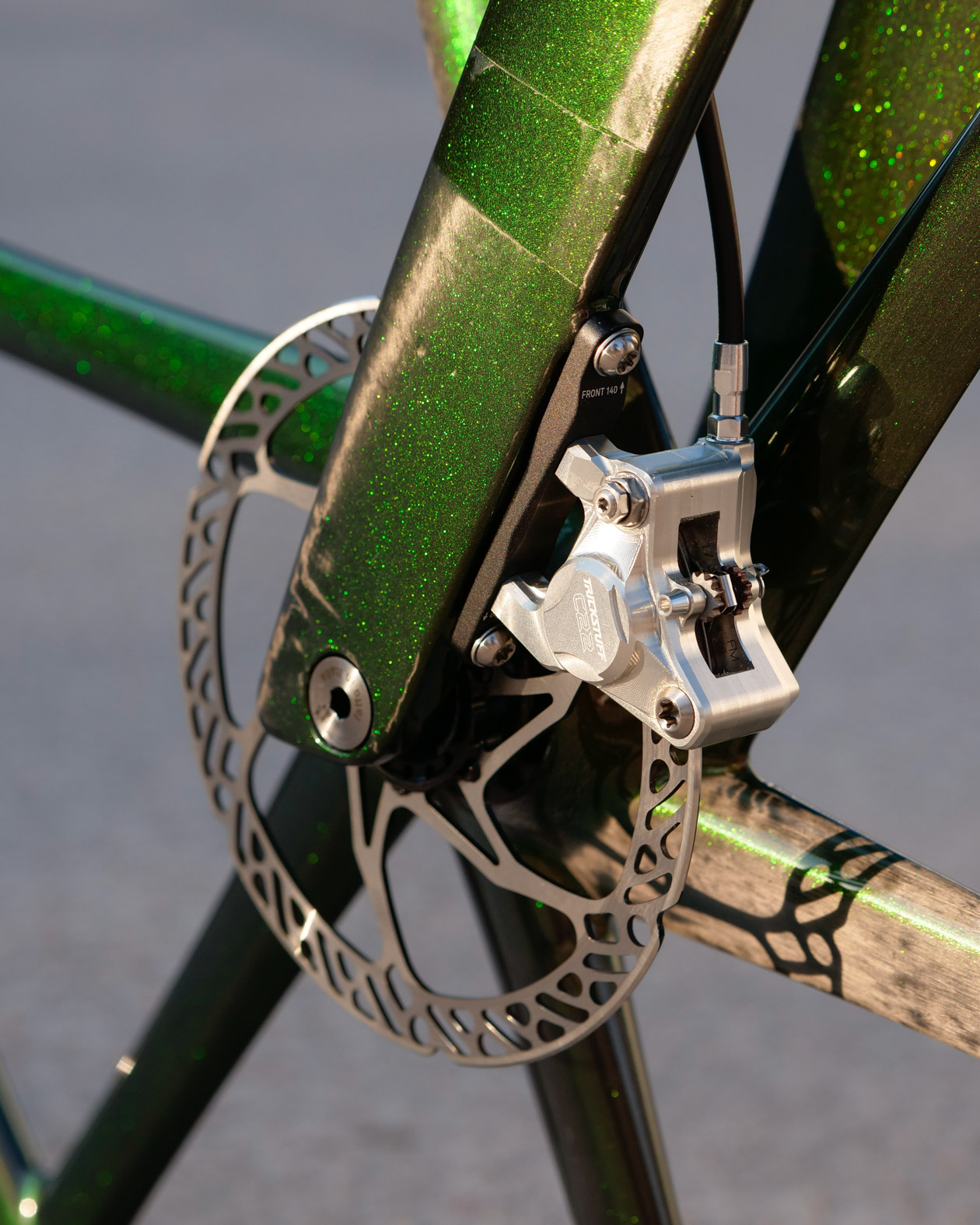
“Over the years Trickstuff have built a somewhat mythical status in the mountain bike world, not only offering the lightest model on the market but also most likely the most powerful ones,” said Gullholm. “Part of their braking performance comes from their own Power brake pads, which tend to score very high in tests. Trickstuff also makes the brake discs used on this bike, which are the Dächle Ultra Light. I’m running 160mm front and 140mm rear, and they are fastened with Bike Ahead Composites The Fixer centerlock adaptors.”
Two saddles, one bike
Where most aero bikes on the market come with a single choice of seatpost to suit the often-proprietary aero shape, Scott has taken a more generous approach with its Foil. Here, and in addition to different setback options, the company offers both the one-piece lightweight Syncros Duncan SL, and the two-piece flexible CFT for increased seated comfort. The latter also provides integration with Syncros’ Campbell 20 Aero rear light.

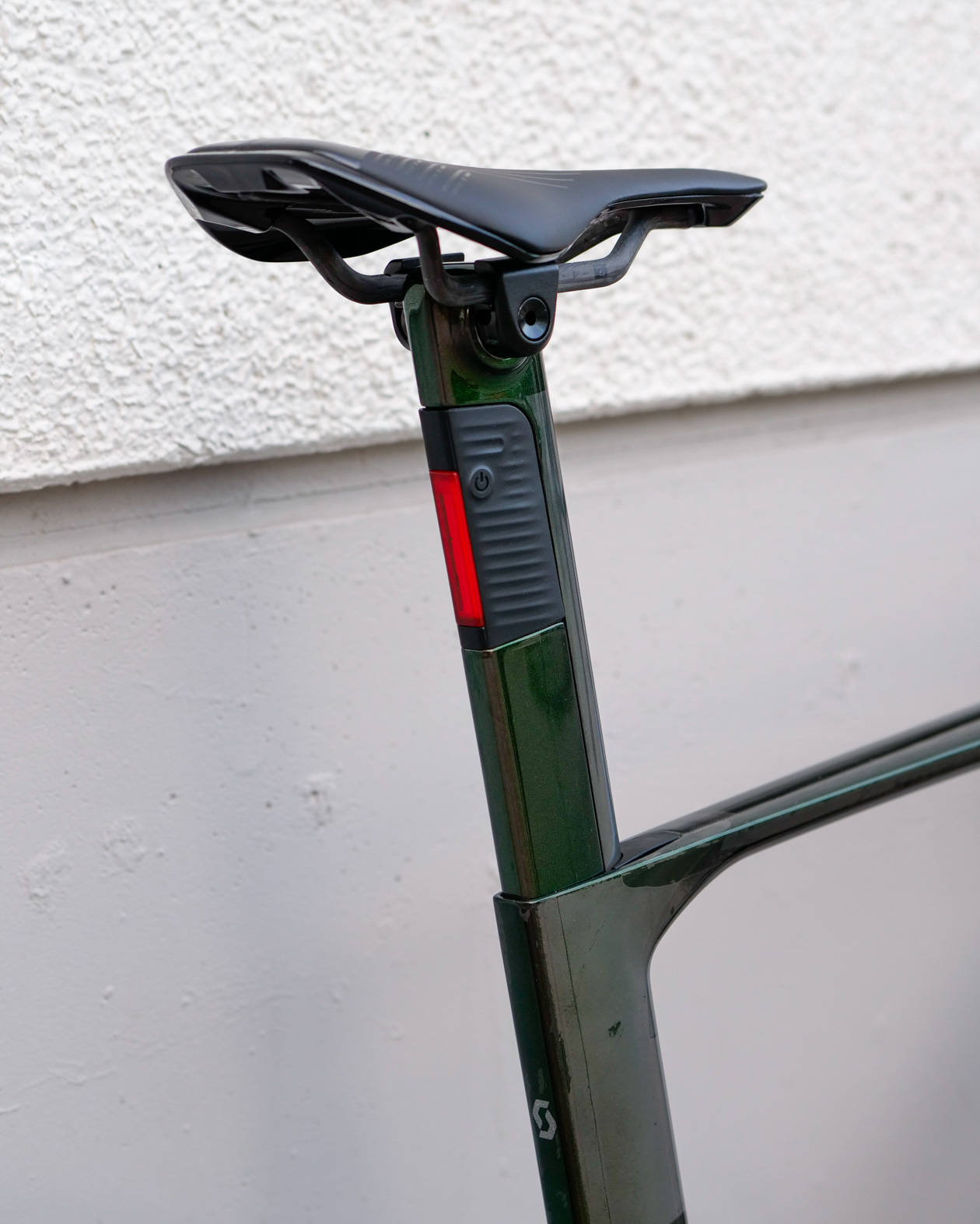
“Since I have both options for this bike, I decided to take the opportunity to run different seats as well. Some people might question this, while I view it a bit like how it for a runner sometimes can be good to mix it up with different shoes,” explained Gullholm.
The lighter-weight seatpost is fitted with a full-carbon Coco Designs Spline saddle, painted to match all the other painted things. “These are handmade in France on a small scale, and it was started as a passion project by the founder, who otherwise works in the aerospace industry.”
According to Gullholmn, this minimalist 65 g saddle offers a surprising amount of flex, making it comfortable perch. And unlike several other lightweight saddles, this one offers well-rounded edges.
Asked about such incredibly light saddles, Gullholm unsurprisingly had some opinions to share. “To me, it’s a mystery how this style of saddle, with a more traditional shape with an upward curve at the tail, has disappeared to such a big extent. These days it’s all about V shapes, flat with no curve, various cutaways and so on. Don’t get me wrong, it’s personal preference and I fully understand that these work for a ton of people. But there are many benefits to the tail style of the Coco Designs and similar. For me, it gives much better pressure relief actually sitting a bit on my glutes and not just having the sit bones like pointed spears into a flat saddle, and it also gives you something to sort of push or lean against in some situations.”

“But luckily, there are a few making saddles like this,” added Gullholm. “In this category you have MCFK, Tune Komm-Vor, Schmolke SL79 and a couple of others. My favorite saddle of all time is a 60-gram Berk in a similar shape, but unfortunately, they never started producing it and mine is just a prototype. The day I crash it will be a day of great sadness,” concluded Gullholm with a laugh.
Meanwhile, the heavier CFT seatpost is fitted with Gullholm’s go-to padded saddle, the Syncros Belcarra V1.0 Cut Out.
Lessons for the future?
It’s quite impressive when you consider this is Gullholm’s first road build (admittedly, he did have a gravel build last year). As expected, some things were learned.
“The main [finding] was probably just how responsive a top-level gravel or road bike is. Not that it’s surprising at all, but in comparison mountain bikes are a bit numb because of the big-volume, low-pressure tires and the suspension sort of dampening your impressions of the bike. A gravel or especially a road bike gives such direct input, that you can easier pinpoint what does what, for example, where it flexes.”
Gullholm admits that this build was refreshingly simple with no suspension or dropper seatpost to contend with but did say that the choice over gearing left him scratching his head. “Of course, this comes down to personal preferences, fitness, and where you actually ride, but there definitely were a few new things to consider. Hopefully, I got it right, but we’ll see in the long run.”
What’s next from the house of Dangerholm? It seems this bike may offer a hint or two. “I mainly just want to continue to try and achieve the level of clean beautiful lines and looks of road bikes like this. I have huge respect for the road scene, from riders to builders, and now that I finally took the step and built such a bike myself I hope that it will help bring me even more inspiration and ideas in the future that can be applied to mountain bikes.”
Build
- Frame: Scott Foil RC HMX Size L/56cm
- Fork: Scott Foil HMX
- Headset: Syncros
- Spacers / Top Cap: Syncros
- Handlebar / Stem: Syncros Creston iC SL Aero 400 x 90 mm
- Bartape: Syncros Super Light
- Saddle: Coco Design Spline 3K 130mm (light option), Syncros Belcarra V 1.0 Cut-Out (comfort option)
- Seatpost: Syncros Duncan SL Aero (light option), Syncros Duncan SL Aero CFT (comfort option)
- Cranks: Sturdy Cycles 3D Printed Titanium 175 mm
- Chainring: Sturdy Cycles Aero 50T
- Bottom Bracket: Kogel Ceramic Road
- Pedals: Wahoo Speedplay Nano
- Chain: SRAM Red
- Cassette: SRAM Force 10-36T or SRAM XPLR 10-44T
- Rear Derailleur: SRAM RED AXS XPLR with Kogel Kolossos Aero cage, polished
- Shifters / Brake Levers: SRAM RED AXS, painted
- Brake Calipers: Trickstuff C22 Flatmount with Trickstuff Power pads
- Brake Rotors: Trickstuff Dächle UL 160 mm front, 140 mm rear
- Brake Hardware: Trickstuff bolts rear, SRAM titanium front
- Wheels: Bike Ahead Composites Aero
- Tyres: Michelin Power Cup Competition Line 25 mm + 28 mm
- Tubes: Revoloop Ultra Race
- Bottle Cages: Syncros Coupe SL
- Extras: Syncros iC Aero by K-Edge GPS mount, Syncros Campbell 20 Aero Light with comfort saddle set up.
Disclaimer: Gustav Gullholm has paid partnerships with several brands (including one large German-based online retailer) used to make his bikes. It turns out that Gustav is so good at customising stock frame builds that he’s made a content-creation career of it.
Escape Collective has no commercial relationship with any of the parties involved. We decided to cover this bike because it’s interesting and not because anyone asked us to.
What did you think of this story?
